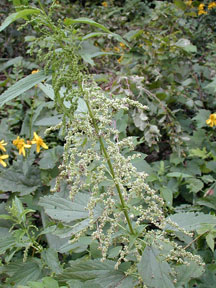STINGING NETTLE
|
 |
| File Size: 121 KB |
|
|
|
Urtica dioica L. subsp. gracilis (Aiton ) Selander
|
| Konza Prairie, Riley County, Kansas |
| Perennial |
| Height: 2-10 feet |
| Family: Urticaceae - Nettle Family |
| Flowering Period: June, July, August, September |
|
| Also Called: | | Tall nettle, slender nettle. | | Stems: | | Erect, usually unbranched, stout, 4-angled, glabrous or stiff hairy, bearing some hollow, stinging hairs. | | Leaves: | | Opposite, simple, lanceolate to ovate, 2 to 8 inches long, .75 to 3 inches wide, surfaces glabrous or minutely hairy; lower surface with stinging hairs, upper surface without or rarely with few stinging hairs; margins coarsely toothed; tips pointed; stalks .5 to 2.5 inches long, with stinging hairs; stipules .2 to .6 inch long, erect, lance-linear. | | Inflorescences: | | Panicle-like clusters, branched, spreading, finger-like, greenish, many-flowered, in upper leaf axils. Stinging nettle can be monoecious or dioecious. When both are present on the same plant, the pistillate flowers are usually above the staminate. | | Flowers: | | Inconspicuous, greenish, unisexual; calyx segments 4, green, nearly equal in staminate flowers, unequal in pistillate flowers; stamens 4; petals absent. | | Fruits: | | Achene, egg-shaped, 1/25 to 1/16 inch long, tan; partially enclosed by 2 inner calyx segments. | | Habitat: | | Stream banks, disturbed sites, ditches, moist lowland woods, thickets, fence rows; moist soil. | | Distribution: | | Throughout Kansas. | | Origin: | | Native | | Uses: | | Several Native American tribes used the plant as a counter-irritant to treat rheumatism. They would rub it on their skin. They used stem fibers to make thread, cords, and bow strings and ate the plant tops as greens. The Lakota steeped the roots and took the liquid for stomach pains. A green dye has been extracted from the leaves. | | Comments: | | A variable species that often grows in dense patches due to rhizomes. The stinging hairs pierce the skin when touched and function like hypodermic needles injecting histamine, acetylcholine, and a neurotoxin. The result is an intense burning and itching sensation. Latin uro "to burn", alludes to the stinging hairs. |
|
| Stinging nettle |  | | 131 KB | | Konza Prairie, Riley County, Kansas |
| | Stinging nettle |  | | 111 KB | | Konza Prairie, Riley County, Kansas |
| | Stinging nettle |  | | 83 KB | | Konza Prairie, Riley County, Kansas |
| | Stinging nettle |  | | 131 KB | | Brown County, Kansas |
| | Stinging nettle |  | | 146 KB | | Brown County, Kansas |
| | Stinging nettle habit |  | | 182 KB | | Marshall County, Kansas |
| | Stinging nettle flowers |  | | 119 KB | | Marshall County, Kansas |
| | | |
|
|
|
|
|
|